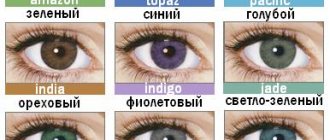What are lenses in physics?
This concept means absolutely any object that is capable of changing the direction of propagation of electromagnetic radiation. This is a general definition of lenses in physics, which includes optical glasses, magnetic and gravitational lenses.
In this article, the main attention will be paid to optical glasses, which are objects made of transparent material and limited to two surfaces. One of these surfaces must necessarily have curvature (that is, be part of a sphere of finite radius), otherwise the object will not have the property of changing the direction of propagation of light rays.
Real and imaginary images
A point source of light is called a real object, and the point of convergence of a beam of rays emerging from a lens is its real image.
An array of point sources distributed on a generally flat surface is important. An example would be a pattern on frosted glass backlit. Another example is a filmstrip illuminated from behind so that the light from it passes through a lens that magnifies the image many times on a flat screen.
In these cases we talk about a plane. Points on the image plane correspond 1:1 to points on the object plane. The same applies to geometric shapes, although the resulting picture may be inverted in relation to the object from top to bottom or from left to right.
The convergence of rays at one point creates a real image, and the divergence creates an imaginary one. When it is clearly outlined on the screen, it is real. If the image can be observed only by looking through the lens towards the light source, then it is called virtual. The reflection in the mirror is imaginary. The picture that can be seen through a telescope is the same. But projecting the camera lens onto the film produces the actual image.
Lens operating principle
The essence of the operation of this simple optical object lies in the phenomenon of refraction of sunlight. At the beginning of the 17th century, the famous Dutch physicist and astronomer Willebrord Snell van Rooyen published the law of refraction, which currently bears his name. The formulation of this law is as follows: when sunlight passes through the interface between two optically transparent media, the product of the sine of the angle of incidence between the beam and the normal to the surface and the refractive index of the medium in which it propagates is a constant value.
To explain the above, let us give an example: let light fall on the surface of water, and the angle between the normal to the surface and the ray is equal to θ1. Then, the light beam is refracted and begins to propagate in water at an angle θ2 to the normal to the surface. According to Snell's law, we obtain: sin(θ1)*n1 = sin(θ2)*n2, here n1 and n2 are the refractive indices for air and water, respectively. What is refractive index? This is a quantity that shows how many times the speed of propagation of electromagnetic waves in a vacuum is greater than that for an optically transparent medium, that is, n = c/v, where c and v are the speed of light in a vacuum and in a medium, respectively.
The physics of refraction lies in the implementation of Fermat's principle, according to which light moves in such a way as to cover the distance from one point to another in space in the least amount of time.
Determination of diopter
Optical power determines the ability to collect rays at one point with a lens. The formula for optical power P, according to definition, is written as follows:
P = 1/f'.
The larger the focal length of the image f', the smaller the value of P. It is measured in reciprocal meters. In physics, it has its own name - diopter. If parallel rays fall on an optical object and, having passed through it, are collected at a point that is located at a distance of 1 meter from the optical center, they speak of an optical power of 1 diopter (1 dp). As you can see, 1 dp is a small amount.
Since f' is a negative value for diverging lenses, the value of P for them will be less than zero.
The formula for optical power can be rewritten as follows:
P = 1/f' = (n' - 1)*(1/R1 - 1/R2).
Thus, the calculation of the value of P is easy to carry out if you know the radii of curvature of the lens and the refractive index of the substance from which it is made.
Types of lenses
The appearance of an optical lens in physics is determined solely by the shape of the surfaces that form it. The direction of refraction of the incident beam depends on this shape. So, if the curvature of the surface is positive (convex), then upon exiting the lens the light beam will propagate closer to its optical axis (see below). On the contrary, if the curvature of the surface is negative (concave), then after passing through the optical glass, the beam will begin to move away from its central axis.
Let us note again that a surface of any curvature refracts rays equally (according to Stell's law), but the normals to them have a different inclination relative to the optical axis, resulting in different behavior of the refracted ray.
A lens that is bounded by two convex surfaces is called a converging lens. In turn, if it is formed by two surfaces with negative curvature, then it is called scattering. All other types of optical glass are associated with a combination of these surfaces, to which a plane is also added. What property the combined lens will have (divergent or converging) depends on the total curvature of the radii of its surfaces.
Species and types
There is a huge variety of optical lenses. However, they can all be grouped according to certain physical criteria:
- Thickness. There are thin and thick glasses in comparison with the radii of curvature R1 and R2 of the surfaces forming the object and with the distances to the object s and its image s'. In practice, thin lenses are most often used.
- Behavior. They are convex and concave. The former collect the beam of light falling on them, the latter scatter it. Converging lenses are usually called positive, and diverging lenses are called negative. Because of these features of their behavior, the images formed can be either real or imaginary.
- Form. Depending on the radius of curvature, there are convex on both sides, convex-concave and concave on both sides. Here the first and third lenses are always converging and diverging, respectively. As for convex-concave glasses, their behavior will depend on the relationship of the radii of curvature. For example, if the concave radius is smaller than the convex radius, then such a lens will scatter rather than collect light rays. The thickness of a convex optical glass is greater at its center, while a concave object is thicker at its edges than in the central part.
When studying the physical properties of optical glasses, their simplified image is used. Convex lenses are shown as a line segment with arrows at its ends facing outward. For diffuse glass, these arrows point inward.
There is another criterion that determines the nature of the passage of rays through the types of objects under consideration. We are talking about comparing the refractive indices of a substance and its environment. It is assumed that this value for the optical object n' is greater than for the medium n (n'>n). For air n=1, so n' must be greater than 1.
Lens elements and ray properties
To construct images in lenses in physics, you need to become familiar with the elements of this object. They are given below:
- Main optical axis and center. In the first case, they mean a straight line passing perpendicular to the lens through its optical center. The latter, in turn, is a point inside the lens, passing through which the beam does not experience refraction.
- Focal length and focus - the distance between the center and the point on the optical axis into which all rays incident on the lens parallel to this axis are collected. This definition is true for collecting optical glasses. In the case of diverging lenses, it is not the rays themselves that will be collected into a point, but their imaginary continuation. This point is called the main focus.
- Optical power. This is the name of the reciprocal of the focal length, that is, D = 1/f. It is measured in diopters (dopters), that is, 1 diopter. = 1 m-1.
The following are the main properties of rays that pass through a lens:
- the beam passing through the optical center does not change the direction of its movement;
- rays incident parallel to the main optical axis change their direction so that they pass through the main focus;
- Rays incident on optical glass at any angle, but passing through its focus, change their direction of propagation in such a way that they become parallel to the main optical axis.
The above properties of rays for thin lenses in physics (they are called so because it does not matter what spheres they are formed of and how thick they are, only the optical properties of the object matter) are used to construct images in them.
Fresnel lenses
Fresnel lenses consist of separate concentric ring-shaped segments adjacent to each other. They received their name in honor of the French physicist Augustin Fresnel, who first proposed and put into practice such a design in lighthouse lighting fixtures. The optical effect of such lenses is comparable to the effect of using traditional lenses of similar shape or curvature.
However, Fresnel lenses have a number of advantages, due to which they are widely used in lighting designs. In particular, they are much thinner and cheaper to manufacture compared to converging lenses. Designers Francisco Gomez Paz and Paolo Rizzatto did not fail to take advantage of these features when working on the bright and magical Luceplan Hope model range.
Made from lightweight, thin polycarbonate, Hope “sheets,” as Gomez Paz calls them, are nothing more than thin and large diffusion Fresnel lenses that create a magical, sparkling, and dimensional glow by being coated with a polycarbonate film textured with microprisms.
Paolo Rizzatto described the project this way: “Why have crystal chandeliers lost their relevance? Because they are too expensive, very difficult to handle and produce. We broke down the idea itself into its components and modernized each of them.”
And here is what his colleague said about this: “Several years ago our attention was attracted by the wonderful capabilities of Fresnel lenses. Their geometric features make it possible to obtain the same optical properties as conventional lenses, but on a completely flat surface of the petals.
However, the use of Fresnel lenses to create such unique products, combining excellent design with modern technological solutions, is still rare.
Such lenses are widely used in lighting scenes with spotlights, where they allow you to create an uneven light spot with soft edges, blending perfectly with the overall light composition. Nowadays, they have also become widespread in architectural lighting schemes, in cases where individual adjustment of the angle of light is required, when the distance between the illuminated object and the lamp can change.
The optical performance of a Fresnel lens is limited by the so-called chromatic aberration that forms at the junctions of its segments. Because of it, a rainbow border appears on the edges of images of objects. The fact that a lens feature that seemed like a disadvantage was turned into an advantage once again emphasizes the strength of the authors' innovative thought and their attitude to detail.
Lighthouse lighting design using Fresnel lenses. The image clearly shows the ring structure of the lens.
Images in optical glasses: how to build?
Below is a figure that shows in detail the schemes for constructing images in the convex and concave lenses of an object (red arrow) depending on its position.
From the analysis of the circuits in the figure, important conclusions follow:
- Any image is built on only 2 rays (passing through the center and parallel to the main optical axis).
- Converging lenses (indicated by arrows at the ends pointing outward) can produce either a magnified or a reduced image, which in turn can be real (real) or virtual.
- If an object is in focus, then the lens does not form its image (see the lower diagram on the left in the figure).
- Diffusing optical glasses (indicated by arrows at their ends directed inward) always give a reduced and virtual image, regardless of the position of the object.
Converging lenses
Converging lenses direct light from a source located at the focal point into a parallel beam of light. As a rule, they are used in lighting structures together with a reflector. The reflector directs the light flux in the form of a beam in the desired direction, and the lens concentrates (collects) the light. The distance between the converging lens and the light source is usually varied, allowing you to adjust the angle you want to achieve.
A system of both a light source and a collecting lens (left) and a similar system of a source and a Fresnel lens (right). The angle of the light flux can be changed by changing the distance between the lens and the light source.
Finding the distance to an image
To determine at what distance the image will appear, knowing the position of the object itself, we present the lens formula in physics: 1/f = 1/do + 1/di, where do and di are the distance to the object and to its image from the optical center, respectively, f is the main focus. If we are talking about collecting optical glass, then the f number will be positive. On the contrary, for a diverging lens f is negative.
Let's use this formula and solve a simple problem: let the object be at a distance do = 2*f from the center of the collecting optical glass. Where will his image appear?
From the conditions of the problem we have: 1/f = 1/(2*f)+1/di. From: 1/di = 1/f - 1/(2*f) = 1/(2*f), that is, di = 2*f. Thus, the image will appear at a distance of two focal points from the lens, but on the other side than the object itself (this is indicated by the positive sign of the di value).
Basic formula
There is an expression that allows you to determine any characteristic of optical glass. It's called the fundamental lens formula. It is sometimes also called the optical glass manufacturer's equation. This expression establishes a clear connection between the distance from the object s and its image s' and the refractive indices of the lens material and the environment, as well as the radii of curvature R1, R2. It can be formulated like this:
n/s' - n/s = (n'-n)*(1/R1 - 1/R2).
Here the quantities s, s', R1, R2 are measured in meters (m) in the SI system. The distances from the optical center to the object (s) and to its image (s') can be either positive or negative. The sign is determined as follows: if the object is in front of the lens, that is, on the left in the figure, then it is taken with the - sign, if on the right, then with the + sign.
The fundamental equation can be found independently by considering the refraction of one ray through each of the curved surfaces. This expression is valid for all types of objects under consideration.
Short story
It is interesting to give the etymology of the word “lens”. It comes from the Latin words lens and lentis, which mean “lentil”, since optical objects in their shape are really similar to the fruit of this plant.
The refractive ability of spherical transparent bodies was known to the ancient Romans. For this purpose they used round glass vessels filled with water. Glass lenses themselves began to be manufactured only in the 13th century in Europe. They were used as a reading tool (modern glasses or a magnifying glass).
The active use of optical objects in the manufacture of telescopes and microscopes dates back to the 17th century (Galileo invented the first telescope at the beginning of this century). Note that the mathematical formulation of Stell's law of refraction, without knowledge of which it is impossible to produce lenses with given properties, was published by a Dutch scientist at the beginning of the same 17th century.
How to decipher a prescription for glasses
During your consultation with an ophthalmologist, diagnostic tests are performed. Visual acuity, refractive ability and other indicators are determined using diagnostic tables and autorefractometry.
After completing all the studies, the patient is given a prescription for glasses. It contains designations consisting of Latin letters. Each of them has its own definition:
- O.D. Indicates all indicators for the right eye.
- OS. Designation for the left eye. All criteria are located just below the designation for the right eye.
- O.U. Disorders that are determined for 2 organs of vision at the same time.
- Sph. Show, identified through the use of diagnostic tables. It means the presence of myopia or hypermetropia, which is respectively determined with a minus or plus sign.
- Cyl. Using this indicator, the optical power of the lens required to correct astigmatism is determined. A cylindrical type of lens is selected.
- Prism. This designation is prescribed if a person needs to select prismatic lenses. They correct myopia, that is, nearsightedness.
- Ax. The indicator indicates the cylindrical tilt of the lens, which is expressed in degrees and has a value from 0 to 180.
- Add. Designation of the difference between the closest and farthest point that a person can see clearly. This measurement is necessary for those people who simultaneously develop nearsightedness and farsightedness. In this case, bifocal or progressive lenses are selected.
- Dd. Designation for the distance between two pupils. This is necessary to identify the center of the lens through which the pupil will look.
An ophthalmologist determines the degree of visual acuity of a person and writes a prescription. To get glasses, you need to go to the optician with this prescription. There, optical devices will be manufactured individually for the patient.
Lens coating
To further protect your eyesight, you can use different functions of glasses:
- UV protection. These are different types of sunglasses with protection ranging from 0 to 4 units. The higher the indicator, the higher the eye protection. This coating forms on top, so it scratches easily. Glasses must be kept in a case at all times to prevent mechanical damage.
- Anti-glare coating. Suitable for people working at a computer or driving a vehicle. This coating protects against long-wave rays reflected from the surface.
- Polarizing coating. Necessary for people who frequently use vehicles. Prevents exposure to vertical and horizontal rays received from headlights, reflective surfaces, and bright skies.
- Hydrophobic coating. It is necessary for frequent changes in temperature conditions so that the lenses do not fog up during operation.
- Hardening coating. When using such elements, the service life of glasses models increases.
When choosing a coating for lenses, it is necessary to take into account the type of human activity. If he often uses a vehicle, it is better to choose polarized glasses. If a person works at a computer for many hours, an anti-reflective coating is suitable.
Materials and wearing modes
One of the main characteristics of lenses is the material from which they are made and the operating mode. Most of them are made from hydrogel and silicone hydrogel components. Hydrogels do not contain silicone, and their main component is water, which evaporates when worn, which leads to a decrease in moisture and the amount of oxygen that reaches the cornea. For these reasons, most of them are one-day use and are not recommended for use for more than 12 hours at a time.
1-Day Acuvue Moist daily contact lenses
Silicone hydrogels, as the name implies, are distinguished by the presence of silicone in their composition. But these are not all the differences. Their percentage of oxygen permeability is very high and can reach up to 170 units, while 80 units are enough to fully provide the eyes. However, due to the generally low amount of moisture, the need for medical solutions and special drops increases. You can use silicone hydrogel lenses for a long period of time, in some products it can reach up to six months.
Traditional Ultra Flex Tint Contact Lenses
As for the replacement mode, experts distinguish: daytime, flexible and prolonged. The first involves operation exclusively during the daytime. Flexible allows the wearer not to take them off for one or even two nights. The extended mode makes it possible to wear ophthalmic products without removing them for a week, and some of them are allowed for continuous use for up to one month.
Lens design
There are 3 main types of lens designs. They are selected by the ophthalmologist together with the patient:
- Spherical. Such models have convex and concave shapes. For example, if you have hypermetropia, it is recommended to choose a biconvex lens to look at objects up close. If a person is nearsighted, the lenses should be biconcave. Such models are selected for people with severely reduced visual acuity. In them, the face does not look aesthetically pleasing, since the eyes visually become much larger or smaller.
- Aspherical. This model is most often presented on the ophthalmological market. The surface of the lens is different from the shape of a sphere. With this feature, the model does not distort the shape and quality of surrounding objects. Such lenses do not have a magnifying function, so they do not enlarge or reduce the size of the eyes. Made from ultra-light materials, so they are practical to use. The disadvantage is the formation of glare, which can negatively affect the quality of vision. This drawback can be eliminated using special anti-reflective coatings. The cost of such models is slightly more expensive than spherical lenses.
- Bi-aspherical. Both surfaces have no convexity or concavity. Therefore, a person’s vision in such glasses is the clearest, there is no distortion of surrounding objects. These lenses are very thin and light.
Experts recommend choosing the latest type of lenses; keep in mind that it will be more expensive.
Lens markings
All information about correction products is on the cardboard box and plastic containers with a metallized foil lid. What parameters does the manufacturer inform the consumer about:
- D - optical power indicator;
- BC—basic curvature parameter;
- DIA - diameter value;
- Dk/t—degree of air permeability.
The image of the sun indicates that the eyes will be reliably protected from ultraviolet radiation. There is also an expiration date on the packaging. It is counted not from the time of production, but from the moment the container is opened.
BASIC GEOMETRIC PARAMETERS AND DESIGNS OF CONTACT LENSES
Contact lens design
Most single vision soft contact lenses are spherical in design, i.e. the optical zone of their front surface is part of a sphere.
However, recently, aspherical design . The optical zone of such contact lenses is aspherical, i.e. the curvature of its surface (the optical power of the contact lens and the quality of vision depend on it) gradually decreases as it moves away from the center of the contact lens to the periphery.
Aspheric design is used in contact lenses to neutralize spherical aberrations inherent in the contact lens and/or eye. Aspheric contact lenses, according to their manufacturers, provide higher quality vision.
Base contact lens curvature
The curvature of the back surface of the contact lens should best match the curvature of the cornea of the eye. For most contact lenses, the central part of their back surface is spherical, which is characterized by the so-called radius of base curvature. The radius of base curvature is usually measured in millimeters. Typical values for this radius range from 7.8 to 9.5 mm. The smaller the radius, the “steeper” the contact lens will fit, and, conversely, the larger the radius of curvature, the flatter the contact lens will fit.
Contact Lens Diameter
The diameter of a contact lens is the distance from one edge of the contact lens to the opposite (through its center). Typically, soft contact lenses have a diameter of 13.0 to 15.0 mm. The most commonly used contact lenses have a diameter of 13.8 mm to 14.5 mm. The radius of base curvature and the diameter of a contact lens are the main geometric parameters of a contact lens that are used by a doctor when selecting contact lenses for a patient.
Optical zone of a contact lens
The optical zone is the central part of the contact lens, which has a given optical power. Typical optical zone sizes are in the range of 8-14 mm; for colored contact lenses, the optical zone can be reduced to 5 mm (uncolored pupil zone).
Center thickness of contact lens
Center thickness refers to the thickness of the contact lens at the geometric center of the contact lens. Typically, plus contact lenses are thick in the center and thin on the edge, while negative contact lenses, on the contrary, are thin in the center and thick on the edge. The thickness at the center also depends on the water content of the material and the size of the optical zone. Some modern contact lenses have a minimum center thickness of about 0.03 mm.
An important characteristic of contact lens geometry is also the thickness and profile of the edge of the contact lens. The thinner the edge of the contact lens, the more comfortable it will be to wear. The thickness and edge design of a contact lens is determined by the manufacturing technology.
We also note that some manufacturers mark their contact lenses by placing a special code on the surface of the contact lenses. The code is usually placed on the front surface of the contact lens and is used to help the patient determine whether the contact lens is inside out (called an inversion indicator).
Untinted and colored contact lenses
And finally, soft contact lenses are now available both untinted (clear) and colored. Contact lenses can be only slightly tinted, which makes handling more comfortable (they say: “tinted for ease of handling”).
Contact lenses can be colored more intensely and these contact lenses enhance the natural color of the eyes. Translucent colored contact lenses are mainly worn by patients with light eyes to give their eyes special expressiveness.
Contact lenses can also be intensely colored (making them completely opaque outside the pupil area), which can dramatically change the natural color of the eyes (both light and dark). Contact lenses that change or enhance the natural color of the eyes are called colored contact lenses.
There are even contact lenses with various funny colored designs (dollar sign, cat's eye, etc.), which are especially popular among young people. They are also classified as colored contact lenses. You can read more about colored contact lenses in the article “Colored Contact Lenses”.
Kepler's astronomical tube and Galileo's terrestrial tube
Let's consider a special case - the telescopic path of rays in a system of 2 lenses, when both the object and the 2nd image are located at infinitely large distances from each other. The telescopic path of rays is carried out in telescopes: Galileo's terrestrial telescope and Kepler's astronomical telescope.
The thin lens has some disadvantages that prevent high-resolution images.
Definition 14
Aberration is a distortion that occurs during the image formation process. Depending on the distance at which the observation is made, aberrations can be spherical or chromatic.
The meaning of spherical aberration is that with wide light beams, rays located at a far distance from the optical axis do not intersect it at the focal point. The thin lens formula only works for rays that are close to the optical axis. The image of a distant source, which is created by a wide beam of rays refracted by a lens, is blurry.
The meaning of chromatic aberration is that the refractive index of the lens material is affected by the light wavelength λ. This property of transparent media is called dispersion. The focal length of a lens is different for light of different wavelengths. This fact leads to image blur when emitting non-monochromatic light.
Modern optical instruments are not equipped with thin lenses, but with complex lens systems in which it is possible to eliminate some distortions.
Instruments such as cameras, projectors, etc. use converging lenses to form actual images of objects.








